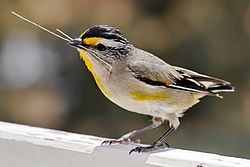| Striated pardalote | |
|---|---|
 | |
| Pardalotus striatus ornatus | |
| Scientific classification | |
| Kingdom: | Animalia |
| Phylum: | Chordata |
| Class: | Aves |
| Order: | Passeriformes |
| Family: | Pardalotidae |
| Genus: | Pardalotus |
| Species: | P. striatus |
| Binomial name | |
| Pardalotus striatus (Gmelin, JF, 1789) | |
The striated pardalote (Pardalotus striatus) is the least colourful and most common of the four pardalote species. Other common names include pickwick, wittachew and chip-chip. [2] It is a very small, short-tailed bird that is more often heard than seen, foraging noisily for lerps and other small creatures in the treetops.




